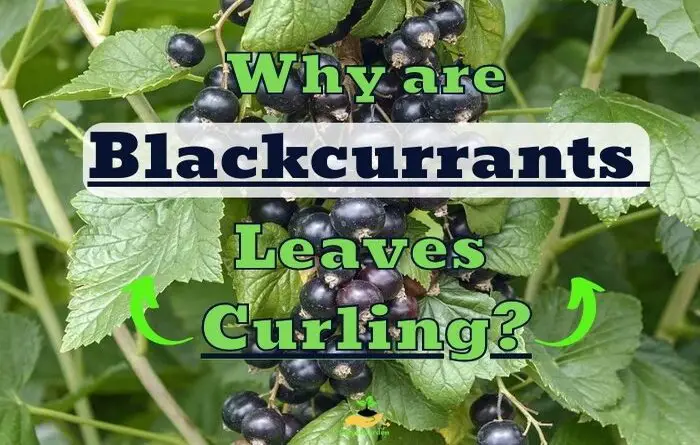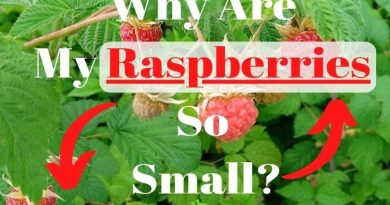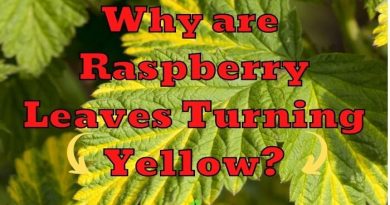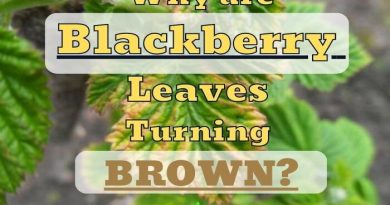Why are my Blackcurrant Leaves Curling? (& How To Fix It)
Gardeners are often faced with the fact that in spring or the middle of summer, when the berries are still ripening, blackcurrant leaves suddenly are curling.
To effectively combat this issue, it is necessary to correctly establish the exact reasons why blackcurrant leaves are curling: either due to fungal diseases or the activity of insect pests.
The cause of leaf curl on blackcurrants is most often an attack by harmful insects or fungal diseases. The main pests that most often infect currants, causing leaf curl, include: aphids, leaf roller, blackcurrant leaf midge, currant clearwing and spider mites. Curled leaves on blackcurrant bushes can also be caused by diseases: Anthracnose, Powdery mildew and Rust.
| Why are blackcurrant leaves curling: |
|---|
| 1. Leafrollers |
| 2. Aphids |
| 3. Spider Mites |
| 4. Blackcurrant Leaf Midge |
| 5. Currant Clearwing |
| 6. Anthracnose |
| 7. Rust |
| 8. Powdery mildew |
The fact that currant leaves curl is to blame for diseases and pests, of which this plant can have quite a lot. Their appearance is facilitated by both weather conditions and violation of agricultural technology.
Pests
If healthy green leaves on blackcurrant bushes suddenly curled into a tube for no apparent reason, most likely pest larvae settled inside.
1. Leafrollers
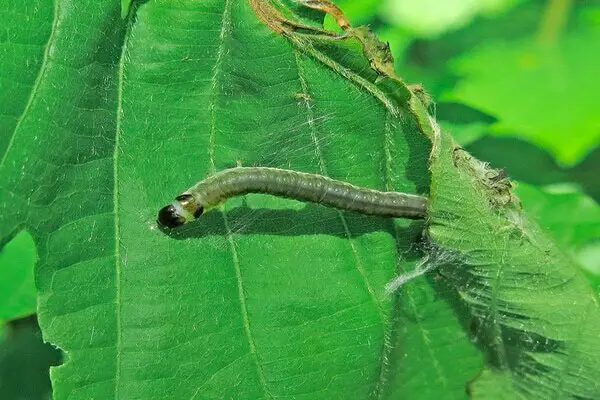
The leafrollers small butterflies lay their eggs on currant bushes. One butterfly is able to lay up to a hundred eggs on the inner surface of blackcurrant leaves within a month, from which yellow or bright green caterpillars will subsequently hatch.
It is these yellow or green caterpillars that cause the blackcurrants leaves to curl up in the classical sense of the word, for which, apparently, it got its name.
At the beginning of the life cycle, their size is only 2 mm, but over the next three weeks, the caterpillars increase 10 times and can cause significant damage to the currant bush.
The danger to currants is represented by yellowish-greenish pest larvae that feed on leaf tissues, forming peculiar “houses” from currant leaves, folding them into a tube and entangling them with cobwebs. If the infected leaf is shaken well, a caterpillar will fall out of it.
They eat leaf blades, and after a while they twist into cocoons, tightened from the inside with a cobweb. In autumn, after the curled leaves fall off, the caterpillars pupate in them and overwinter. In the spring, butterflies will again appear from the pupae, which will begin to lay eggs on the blackcurrant.
Treatment
As a preventive measure, gardeners need to cut off all curled blackcurrant leaves and carefully loosen the trunk circle around the shrub.
With the onset of autumn, it is advisable to rake and destroy all fallen leaves (the fewer larvae remain to winter under the plant, the fewer pests will appear next year).
Leaving them in a circle near the trunk or in a compost heap, the gardener will give the larvae the opportunity to overwinter, and in the spring the butterflies will return again.
For severe infestations, insecticides must be used. Plant protection products produced on a biological basis are becoming increasingly popular.
Start collecting and burning fallen leaves, loosening and hilling bushes in the fall, as well as mulching plants before flowering. During the growing season, currants, as well as gooseberries growing next to it, are treated with insecticides.
2. Aphids
Most often, currant leaves start curling with the edges turned inward because of the attack of two types of aphids:
- Gall Leaf Aphids
- Gooseberry Aphids
Currant attracts many types of aphids, but the leaves are most often curled due to the activity of gall aphids.
Gall Leaf Aphids
The gall leaf aphid (Cryptomyzus ribis) prefers the red and white currant varieties. With the onset of spring, its larvae populate the apical shoots of the shrub and begin to actively feed on the juice of young leaves, damaging them from the back. These small insects can be easily spotted with the naked eye.
The morphological and anatomical alterations of plant organs caused by the saliva of aphids, which contains auxins substances. These induce alterations in the development of the currant leaves which appear curled and rolled up; there will be a smaller leaf surface and a reduction in the assimilative activity.
You can identify gall leaf aphids by the characteristic swellings on the leaves of the currant, which are soon covered with red spots. The pest itself inhabits the undersides of leaf plates.
For wintering, the gall aphid climbs under the bark of currant branches. As soon as the foliage begins to bloom with the advent of spring, the gall aphid larvae come out.
And since its presence on the currant can sometimes be confused with the manifestation of anthracnose, examine the foliage carefully:
Goosberry Aphids
Goosberry Aphid (Aphis grossulariae) has a greenish color. Most often, it is the reason why the upper leaves of the blackcurrant are curling. First, the insect sucks the juice from the lower leaves, then moves to the tops of the shoots. As a result, young blackcurrant leaves curl outward in shapeless lumps.
This species of aphid is in symbiosis with ants, which are able to transfer these insects from one plant to another. In addition, the ant colony provides them with protection from external enemies, receiving in return the sweetish liquid secreted by aphids.
The damage to plants can be quite noticeable, the leaves of the apical shoots on the blackcurrant wrinkle and curl down at their edges, gradually drying out and falling off ahead of time.
With severe damage to aphids, the immunity of even an adult bush is greatly weakened, as a result of which the blackcurrant may not survive the cold winter.
Treatment
Spill aphid-infested bushes with water from a hose so that the plants remain intact, and all insects are washed away to the ground. They will not be able to climb back themselves, but we have already written above about the fight against the ants that drag them.
The aphid does not tolerate the smell of tar soap: a solution of 100 g of the substance per 10 liters of water will permanently save your currant bushes, treated with a sprayer, from an uninvited guest.
And here is another good recipe: brew a glass of tobacco leaves or just tobacco from cigarette butts in 5 liters of boiling water, leave for a day and strain. Just keep in mind that plants can be treated with this solution at least a week before harvest.
You can also use an infusion from a crushed head of garlic, a few pods of hot pepper, or 3-5 horseradish roots per 3 liters of water. Leave for a day, then strain and spray the currants leaves.
You can scare away these insects with the help of repellent plants that have a strong natural smell. Such crops include calendula, thyme, mint, lemon balm, parsley, onion, garlic, dill, basil and other plants.
3. Spider Mites
Red spider mite (Tetranychus urticae) is a common causes of blackcurrant leaves curling , a mite belonging to the Tetranychidae family which feeds on the leaves of various plant species.
It is above all the larvae that cause damage to the blackcurrant leaves as they feed on the mesophyll cells thanks to their biting-sucking mouthparts. We can see that these leaves will become bronze in color and will lose, partially or totally, their photosynthesizing function.
Subsequently, blackcurrant leaves lose their original structure, start curling and fall off prematurely.
It is very difficult to detect a spider mite with the naked eye, because it has a miniature size (the male individual reaches no more than 0.5 mm in length, while the female can be twice as large). A characteristic symptom of infection is the presence of a thin white web on the back of the leaf blades.
If measures are not taken in time, then the currant bush exhausted by the pest, will cease to bear fruit, and subsequently die.
Treatment
The best method to eliminate red spider mites is the use of other mites belonging to the phytoseiid family, its antagonists and predators, which develop on various biological materials, such as pollen and fungi. The most effective and used worldwide as a predator is Phytoseiulus persimilis.
It is desirable to treat blackcurrants before the appearance of flowers on the shrubs.
Homemade remedies such as infusions of calendula, celandine, onion, garlic and potato tops demonstrate the greatest effectiveness.
At the same time, blackcurrants should be treated daily, at least three times in a row, since pest eggs have a high degree of resistance to the effects of drugs.
Preventive measures include moistening the soil and the plants themselves (mites reproduce best at a humidity of 30-50%), as well as top dressing with complex preparations with a high content of potassium and phosphorus.
4. Blackcurrant Leaf Midge
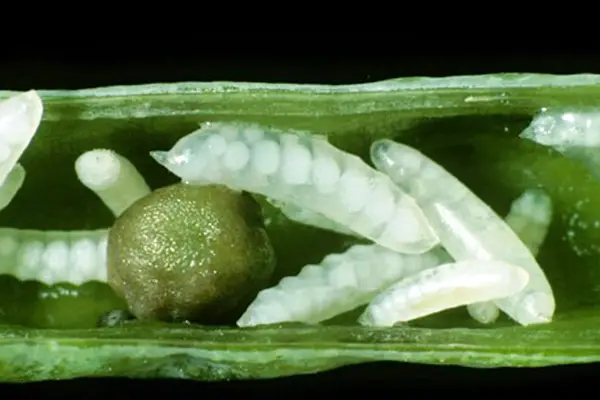
Blackcurrant Leaf Curling Midge (Dasineura tetensi) is the most common species. This type of pest lays eggs in cracks and crevices of the bark after the end of the currant flowering phase.
Since the larvae drink the juices of the blackcurrant plant, the branches become brittle and dry out rapidly, while the leaves on them curl and die.
Females lay eggs on blackcurrant leaf blades, several at a time. Under favorable weather conditions, during the life cycle, insects are able to produce three to four generations of offspring.
The larvae of the blackcurrant leaf curling midge gather in colonies and feed on the tissues of the stem, due to which the bark acquires a dark brown hue and appears as if depressed spots appear on it. The process is accompanied by curling, darkening and falling of the leaves.
Massive pest infestations can lead to the death of shoots. Gall midge larvae are especially dangerous for young annual plants.
The length of white and red gall midge larvae, which directly damage the leaves, does not exceed 1.5 mm, which makes it extremely difficult to detect them.
Treatment
Pest control usually involves the use of pesticides. Many gardeners recommend in early spring, even before bud break, to treat currants with boiling water. For this purpose, the stems of the shrub are first tied into a bundle, and then poured with hot water.
During the pouring of boiling water into the watering can and the watering itself, the water temperature drops to approximately 80 ° C. If the treatment time is chosen correctly, such a temperature will not harm the bushes, and it will destroy insects and mites.
If the processing time is chosen correctly, such a temperature will not harm the bushes, and it will destroy insects and mites.
And in the future, for prevention during the growing season, plants are sprayed with biological insecticide according to the instructions.
Additionally, they implement the same set of preventive measures as for other pests: they burn fallen leaves and plant debris, loosen and spud blackcurrant bushes in the fall, and also mulch the bushes before they bloom.
5. Currant Clearwing
Most often, currant clearwing (Synanthedon tipuliformis) also called currant borer, affects blackcurrants, although it can also occur on red currants.
Outwardly, the imago resembles a small wasp with yellow transverse stripes on a black abdomen and transparent glassy wings. An adult does not pose a danger to currants, since it feeds exclusively on flower pollen.
But its larvae penetrate the blackcurrant stems and eat them out. As a result, the blackcurrant leaves will curl, but no additional external signs are observed.
Currants are harmed by caterpillars, which usually appear 10–12 days after the plant has faded. The larva has a yellowish body with a brown head.
It bites into the inner part of the stem, where it lives and feeds, gradually moving from the top to the base of the shoot, making long moves in it. Subsequently, the affected currant branches dry up, starting from the top, and the curled leaves fall off.
At the same time, the presence of the pest does not manifest itself outwardly. To make sure your currant has fallen prey to clearwing larvae, remove the affected branch and cut it lengthwise.
If a hollow middle with black walls appears on the cut, and the inner walls of the stem are black, it means that the currant bush is infected with this pest.
Treatment
To date, no varieties of currants and gooseberries have been bred that are resistant to the activity of the currant clearwing caterpillar.
In the event that the clearwing larvae have completely occupied the bush, all affected stems must be removed by cutting them off at the very base. If only individual shoots are damaged, they can be cut back to healthy tissue. All cut stems must be burned.
Of the chemical means of protection, insecticides can be used. However, due to the fact that the larva is inside and is reliably protected from all sides, methods of chemical exposure are ineffective.
However, timely treatment of currants with chemicals can lead to the mass death of butterflies during their active flight and will not make it possible to lay eggs.
As a preventive measure, currant bushes can be treated with an infusion with a pronounced aroma, which has a repellent effect on insects. For this purpose, infusions of onion, garlic husks or orange peels are usually used.
Many gardeners plant plants with a strong smell next to currants, for example, calendula, nasturtium, marigolds.
Diseases
If the leaves on the currant curl even despite careful care and regular watering, then the cause of the disease lies not in the lack of moisture and nutrition. Most likely, the plantings were struck by a fungal infection, the symptoms of which can appear from early spring to mid-summer.
6. Anthracnose
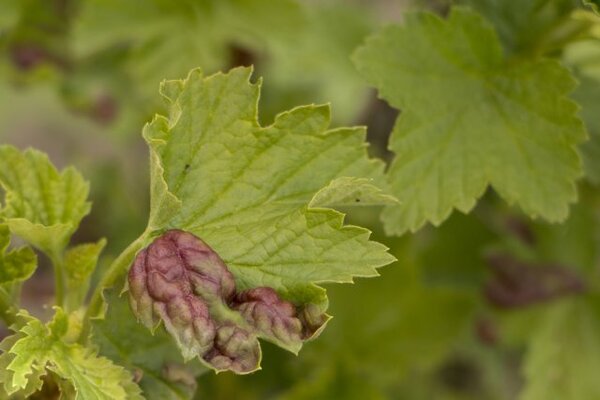
Anthracnose is a disease caused by species of fungi belonging to the genus Colletotrichum of the Glomerellaceae family. The symptoms on the leaves are manifested by the appearance of brown-red spots that expand gradually. Over time, blackcurrant leaves will start curling, turn red, and then fall off.
The first symptoms of anthracnose on currants usually begin to appear in late spring or early summer. In this case, the lower leaves of the shrub are infected first of all.
The most favorable weather for the development of the disease is an increased level of humidity at high air temperature.
If anthracnose is detected, not only currants should be treated with chemicals, but also shrubs and trees growing near it. The disease negatively affects the winter hardiness, development and yield of a number of garden plants.
Treatment
As an anthracnose prevention in the spring, currants are treated annually with 1% Bordeaux liquid (repeat after harvesting).
Since the fungus overwinters in fallen leaves, in the fall, it must be carefully raked out from under the bushes and burned. Among the preventive measures is the treatment of plants with one of the above drugs according to the instructions.
The main preventive means of combating infection are the timely pruning of shoots, thorough cleaning of fallen leaves and sanitary digging of the soil around the trunk circles.
7. Rust
The main symptom of rust on blackcurrants is yellowish-orange spots that appear on the leaves. The disease appears in the middle of the growing season. The reverse side of the leaf blades is covered with dense growths with rusty spores, which gradually darken, curl and fall prematurely.
Treatment
As a preventive measure, at the time of leaf blooming, it is advisable to treat currants with a 1% solution of Bordeaux mixture. With the onset of autumn, all fallen leaves must be removed, and the soil in the trunk circles must be dug up.
In the same period, it is desirable to make sanitary pruning of plants, removing all stems that are more than 5 years old.
A good effect is demonstrated by the treatment of plants with hot water, which is carried out at the beginning of early spring, even before the buds swell.
8. Powdery mildew
The infection primarily affects blackcurrants, but can also be found on red ones. The disease manifests itself in the form of a characteristic powdery coating on leaves and stems.
Later, the blackcurrant leaves color becomes brown and start curling inward, as if they want to close. Subsequently, the disease spreads to other parts of the plant. At the same time, the berries shrink and the growth of the bush stops, which will die if urgent action is not taken.
Powdery mildew spores remain viable for 6 years. If the disease is not fought, then after 2-3 years the plant, as a rule, dies.
Treatment
Since the development of the disease is promoted by dry or oversaturated soil with nitrogen, timely watering and fertilizing currants, as well as normalizing the acidity of the soil under it, are suitable as biological measure
Preventive measures to protect currants include careful cleaning of fallen leaves, timely pruning of infected stems and twisted leaves.
Of the modern fungicides, biological products are most often used, which include special types of fungi and bacteria that have a detrimental effect on pathogenic fungi.
As home remedies, you can use an infusion of wood ash or a solution of potassium permanganate (half of teaspoon of potassium permanganate per 10 liters of water).
How to Prevent Blackcurrant Leaves from Curling
Here are ways you can prevent blackcurrant leaves from curling:
- Select healthy seedlings without signs of disease and visible damage.
- In the spring, currant bushes can be treated with a 1% solution of Bordeaux mixture or boric acid to protect from many fungal infections.
- Before planting in the ground, blackcurrant seedlings should be kept for 15 minutes in warm, about 113°F (45°C) water to be disinfected from parasitic insects.
- When planting blackcurrants, you need to ensure that the distance between the bushes is 70-80 cm.
- During the season, weeding and loosening the soil are carried out
- All damaged (dried and deformed) shoots must be cut off immediately after a fungus infestation.
- When the currant sheds its leaves in the fall, the shrub is treated with a 1% solution of copper sulfate.
- Smelling vegetation planted nearby will help scare away pests: marigold, calendula, yarrow, tansy, dill, garlic.
- Get rid of weeds under the blackcurrant bushes, mow overgrown grass.
Conclusion
When you notice your blackcurrant leaves are curling, you should try to figure out what caused this symptom as quickly as possible. In order to determine what exactly happened to your blackcurrant, you need to carefully examine the plants.
After identifying a fungal disease or pest, you should pick the necessary treatments and treat the shrub immediately away.
Good luck!

